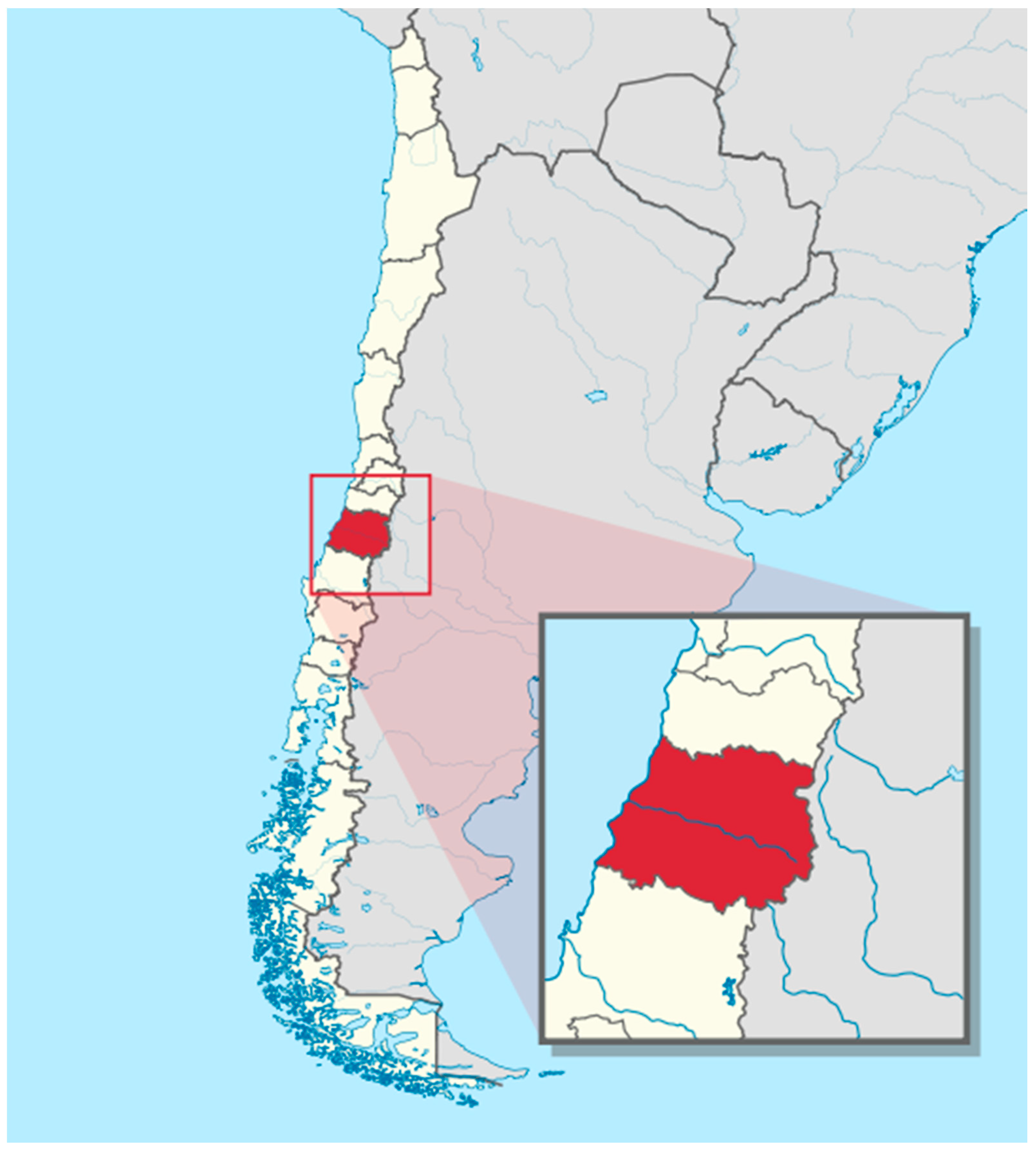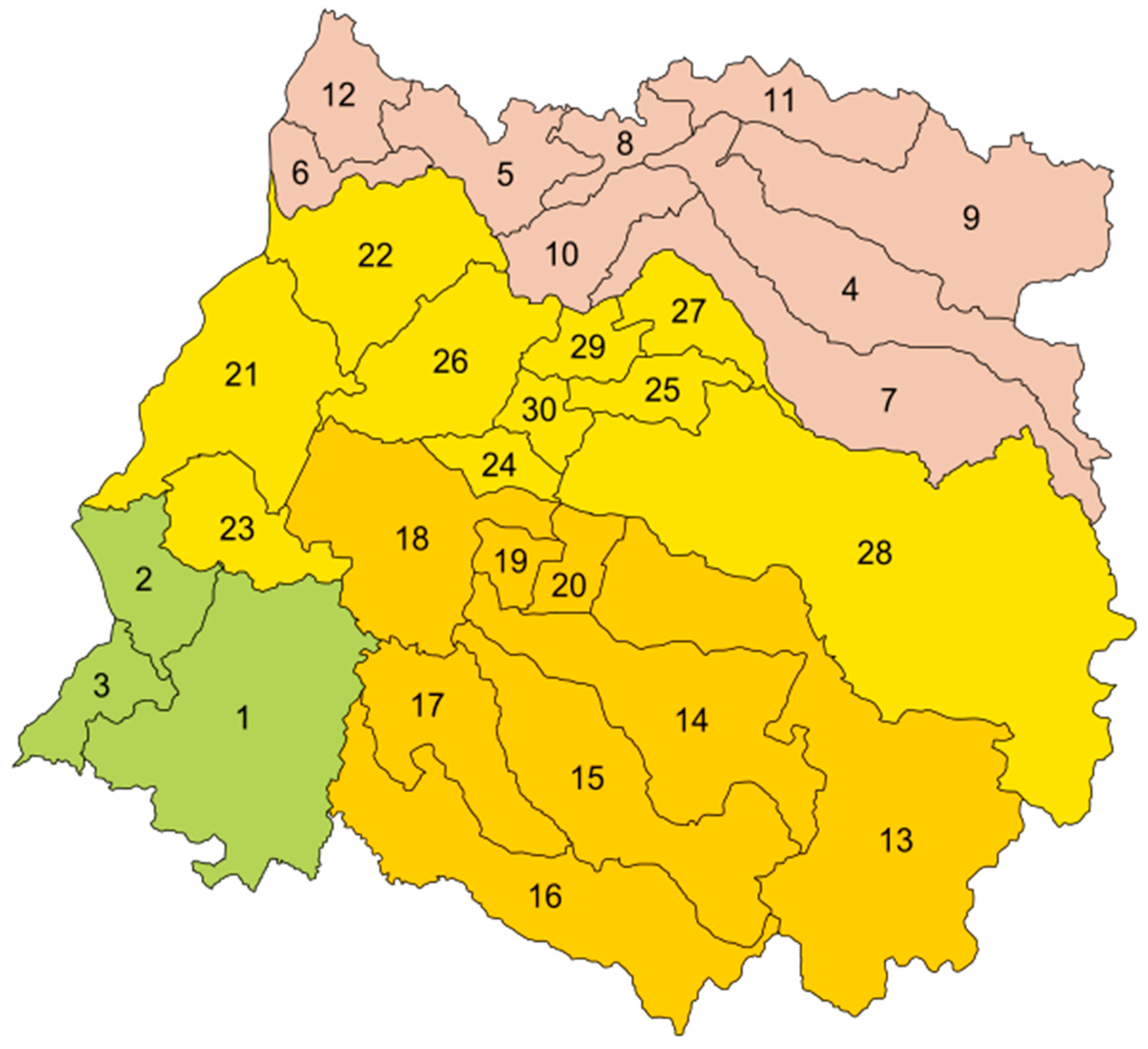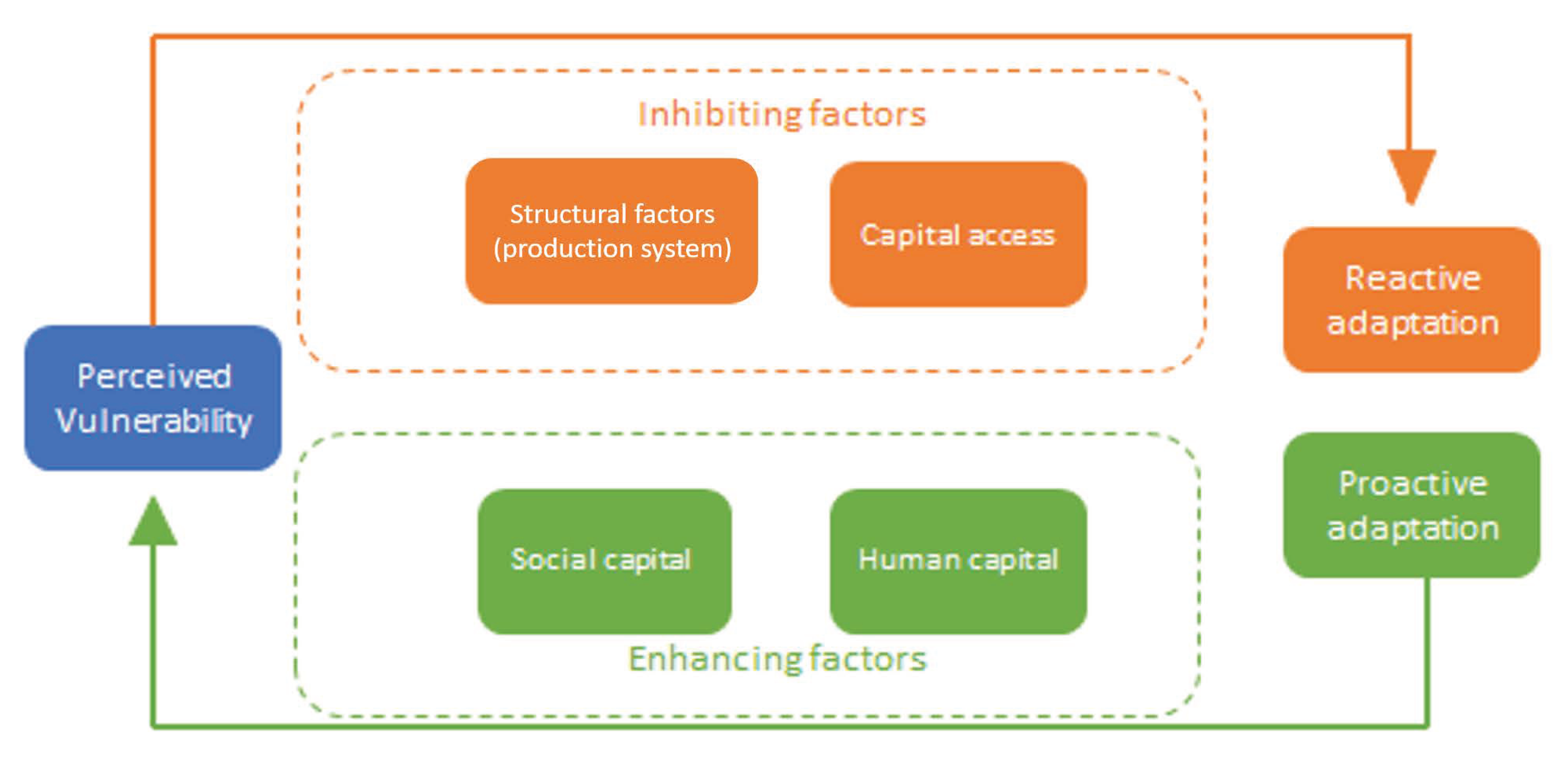Farmers’ Perceived Vulnerability and Proactive versus Reactive Climate Change Adaptation in Chile’s Maule Region
Abstract
:1. Introduction
2. Theoretical Background
2.1. Adaptation to Climate Change
2.2. Vulnerability to Climate Change and Adaptation
2.3. Structural and Social Factors Explaining Adaptation
2.4. Proposed Study Approach
3. Method
3.1. Research Site
3.2. Participants
3.3. Interview Procedure
3.4. Analyses
4. Results
4.1. Perceptions of Climate Change and Challenges
4.2. Perceived Vulnerability, Proactive and Reactive Adaptation
4.3. Structural Factors, Human, and Social Capital
4.3.1. Structural and Economic Factors
4.3.2. Human and Social Capital
5. Conclusions and Discussion
Author Contributions
Funding
Institutional Review Board Statement
Informed Consent Statement
Data Availability Statement
Conflicts of Interest
References
- IPCC. Summary for Policymakers. In Global Warming of 1.5 °C; An IPCC Special Report on the impacts of global warming of 1.5 °C above pre-industrial levels and related global greenhouse gas emission pathways, in the context of strengthening the global response to the threat of climate change, sustainable development, and efforts to eradicate poverty; Masson-Delmotte, V., Ed.; World Meteorological Organization: Geneva, Switzerland, 2018. [Google Scholar]
- Howden, S.M.; Soussana, J.F.; Tubiello, F.N.; Chhetri, N.; Dunlop, M.; Meinke, H. Adapting agriculture to climate change. Proc. Natl. Acad. Sci. USA 2007, 104, 19691–19696. [Google Scholar] [CrossRef] [Green Version]
- Mertz, O.; Mbow, C.; Reenberg, A.; Diouf, A. Farmers’ perceptions of climate change and agricultural adaptation strategies in rural Sahel. Environ. Manag. 2008, 43, 804–816. [Google Scholar] [CrossRef] [PubMed]
- Schmidhuber, J.; Tubiello, F.N. Global food security under climate change. Proc. Natl. Acad. Sci. USA 2007, 104, 19703–19708. [Google Scholar] [CrossRef] [Green Version]
- Tittonell, P. Assessing resilience and adaptability in agroecological transitions. Agr. Syst. 2020, 184, 102862. [Google Scholar] [CrossRef]
- FAO. Tracking Adaptation in Agricultural Sectors: Climate Change Adaptation Indicators. 2017. Available online: http://www.fao.org/3/i8145e/i8145e.pdf (accessed on 2 September 2021).
- IPCC. Climate Change 2007: Impacts, Adaptation and Vulnerability. Intergovernmental Panel on Climate Change Fourth Assessment Report; IPCC: Geneva, Switzerland, 2007. [Google Scholar]
- Chen, H.; Wang, J.; Huang, J. Policy support, social capital, and farmers’ adaptation to drought in China. Glob. Environ. Chang. 2014, 24, 193–202. [Google Scholar] [CrossRef]
- Engler, A.; Jara-Rojas, R.; Bopp, C. Efficient use of water resources in vineyards: A recursive joint estimation for the adoption of irrigation technology and scheduling. Water Resour. Manag. 2016, 30, 5369–5383. [Google Scholar] [CrossRef]
- Handschuch, C.; Wollni, M. Improved production systems for traditional food crops: The case of finger millet in western Kenya. Food Secur. 2016, 8, 783–797. [Google Scholar] [CrossRef] [Green Version]
- Roco, L.; Engler, A.; Bravo-Ureta, B.; Jara-Rojas, R. Farm level adaptation decisions to face climatic change and variability: Evidence from Central Chile. Environ. Sci. Policy 2014, 44, 86–96. [Google Scholar] [CrossRef]
- Dasgupta, P.; Morton, J.F.; Dodman, D.; Karapinar, B.; Meza, F.; Rivera-Ferre, M.G.; Vincent, K.E. Rural areas. In Climate Change 2014: Impacts, Adaptation, and Vulnerability. Part A: Global and Sectoral Aspects. Contribution of Working Group II to the Fifth Assessment Report of the Intergovernmental Panel on Climate Change; Field, C.B., Barros, V.R., Dokken, D.J., Mach, K.J., Mastrandrea, M.D., Chatterjee, S.M.M., Ebi, K.L., Estrada, Y.O., Genova, R.C., Girma, B., Eds.; Cambridge University Press: Cambridge, UK; New York, NY, USA, 2014; p. 613. [Google Scholar] [CrossRef]
- Tambo, J.A.; Abdoulaye, T. Climate change and agricultural technology adoption: The case of drought tolerant maize in rural Nigeria. Mitig. Adapt. Strateg. Glob. Chang. 2012, 17, 277–292. [Google Scholar] [CrossRef]
- Carman, J.; Zint, M.T. Defining and classifying personal and household climate change adaptation behaviors. Glob. Environ. Chang. 2020, 61, 102062. [Google Scholar] [CrossRef]
- Deuffic, P.; Garms, M.; He, J.; Brahic, E.; Yang, H.; Mayer, M. Forest Dieback, a Tangible Proof of Climate Change? A Cross- Comparison of Forest Stakeholders’ Perceptions and Strategies in the Mountain Forests of Europe and China. Environ. Manag. 2020, 66, 858–872. [Google Scholar] [CrossRef]
- Grothmann, T.; Patt, A. Adaptive capacity and human cognition: The process of individual adaptation to climate change. Glob. Environ. Chang. 2005, 15, 199–213. [Google Scholar] [CrossRef]
- Adger, W.N.; Dessai, S.; Goulden, M.; Hulme, M.; Lorenzoni, I.; Nelson, D.R.; Anita, J.W. Are there social limits to adaptation to climate change? Clim. Chang. 2009, 93, 335–354. [Google Scholar] [CrossRef]
- Arbuckle, J.G.; Morton, L.W.; Hobbs, J. Farmer beliefs and concerns about climate change and attitudes toward adaptation and mitigation: Evidence from Iowa. Clim. Chang. 2013, 118, 551–563. [Google Scholar] [CrossRef] [Green Version]
- Arbuckle, J.G.; Prokopy, L.S.; Haigh, T.; Hobbs, J.; Knoot, T.; Knutson, C.; Widhalm, M. Climate change beliefs, concerns, and attitudes toward adaptation and mitigation among farmers in the Midwestern United States. Clim. Chang. 2013, 117, 943–950. [Google Scholar] [CrossRef] [Green Version]
- Garreaud, R.; Boisier, J.P.; Rondanelli, R.; Montecinos, A.; Sepúlveda, H.; Veloso-Águila, D. The Central Chile Mega Drought (2010–2018): A Climate dynamics perspective. Int. J. Climatol. 2019, 40, 421–439. [Google Scholar] [CrossRef]
- De Cambio Climatico, O.; del Medio Ambiente, M. Plan Nacional de Adaptación al Cambio Climático. 2014. Available online: http://www.a2c2.utalca.cl/docs/documentos/PAN-web2.pdf (accessed on 2 August 2020).
- ODEPA. Chilean Agriculture Overview. 2017. Available online: https://www.odepa.gob.cl/wp-content/uploads/2017/12/panoramaFinal20102017Web.pdf (accessed on 2 August 2020).
- Engler, A.; Poortvliet, P.M.; Klerkx, L. Toward understanding conservation behavior in agriculture as a dynamic and mutually responsive process between individuals and the social system. J. Soil Water Conserv. 2019, 74, 74A–80A. [Google Scholar] [CrossRef]
- Robert, M.; Thomas, A.; Bergez, J.E. Processes of adaptation in farm decision-making models: A review. Agron. Sustain. Dev. 2016, 36, 64. [Google Scholar] [CrossRef] [Green Version]
- UNFCCC. Adoption of the Paris Agreement. Paris Agreement text English. 2015. Available online: https://unfccc.int/sites/default/files/english_paris_agreement.pdf (accessed on 2 August 2020).
- Zilberman, D.; Zhao, J.; Heiman, A. Adoption versus Adaptation, with emphasis on climate change. Annu. Rev. Resour. Econ. 2012, 4, 27–206. [Google Scholar] [CrossRef] [Green Version]
- Schilling, J.; Freier, K.P.; Hertig, E.; Scheffran, J. Climate change, vulnerability and adaptation in North Africa with focus on Morocco. Agric. Ecosyst. Environ. 2012, 156, 12–26. [Google Scholar] [CrossRef]
- Cruz, G.; Baethgen, W.; Bartaburu, D.; Bidegain, M.; Giménez, A.; Methol, M.; Morales, H.; Picasso, V.; Podestá, G.; Taddei, R.; et al. Thirty Years of Multilevel Processes for Adaptation of Livestock Production to Droughts in Uruguay. Am. Meteorol. Soc. 2018, 10, 59–74. [Google Scholar] [CrossRef]
- Repetto, R. The Climate Crisis and the Adaptation Myth. EliScolar—A Digital Platform for Scholarly Publishing at Yale. 2008. Available online: https://elischolar.library.yale.edu/cgi/viewcontent.cgi?article=1019&context=fes-pubs (accessed on 2 August 2020).
- Roche, L. Adaptive rangeland decision-making and coping with drought. Sustainability 2016, 8, 1334. [Google Scholar] [CrossRef] [Green Version]
- Duy Minh, D.; Dan Hao, N.; Lebailly, P. Adapting to Climate Extreme Events Based on Livelihood Strategies: Evidence from Rural Areas in Thua Thien Hue Province, Vietnam. Sustainability 2020, 12, 10498. [Google Scholar] [CrossRef]
- IPCC. Annex II: Glossary. 2014. Available online: https://archive.ipcc.ch/pdf/assessment-report/ar5/syr/AR5_SYR_FINAL_Annexes.pdf (accessed on 2 September 2021).
- Darabant, A.; Habermann, B.; Sisay, K.; Thurnher, C.; Worku, Y.; Damtew, S.; Lindtner, M.; Burrell, L.; Abiyu, A. Farmers’ perceptions and matching climate records jointly explain adaptation responses in four communities around Lake Tana, Ethiopia. Clim. Chang. 2020, 163, 481–497. [Google Scholar] [CrossRef]
- Jamschidi, O.; Asadi, A.; Kalantari, K.; Azadi, H.; Scheffran, J. Vulnerability to climate change of smallholder farmers in the Hamadan province, Iran. Clim. Chang. Manag. 2019, 23, 146–159. [Google Scholar] [CrossRef]
- Singh, S. Bridging the gap between biophysical and social vulnerability in rural India: A community livelihood vulnerability approach. Area Dev. Policy 2020, 5, 390–411. [Google Scholar] [CrossRef]
- Malherbe, W.; Sauer, W.; Aswani, S. Social capital reduces vulnerability in rural coastal communities of Solomon Islands. Ocean Coast. Manag. 2020, 191, 105186. [Google Scholar] [CrossRef]
- Mortreux, C.; O’Neill, S.; Barnett, J. Between adaptive capacity and action: New insights into climate change adaptation at the household scale. Environ. Res. Lett. 2020, 15, 074035. [Google Scholar] [CrossRef]
- Pahm, N.T.T.; Nong, D.; Sathyan, A.R.; Garschagen, M. Vulnerability assessment of households to flash floods and landslides in the poor upland regions of Vietnam. Clim. Risk Manag. 2020, 28, 100215. [Google Scholar] [CrossRef]
- Tran, D.D.; Quang, C.N.X.; Duy Tien, P.; Tran, G.; Long, P.K.; Van Hoa, H.; Giang, N.N.H.; Thu Ha, L.T. Livelihood Vulnerability and Adaptation Capacity of Rice Farmers under Climate Change and Environmental Pressure on the Vietnam Mekong Delta Floodplains. Water 2020, 12, 1328. [Google Scholar] [CrossRef]
- Wichern, J.; Descheemaeker, K.; Giller, K.E.; Ebanyat, P.; Taulya, G.; van Wijk, M.T. Vulnerability and adaptation options to climate change for rural livelihoods–A country-wide analysis for Uganda. Agric. Syst. 2019, 176, 102663. [Google Scholar] [CrossRef]
- Alam, G.M.; Alam, K.; Mushtak, S. Climate change perceptions and local adaptation strategies of hazard-prone rural households in Bangladesh. Clim. Risk Manag. 2017, 17, 52–63. [Google Scholar] [CrossRef]
- Christian, A.K.; Dovie, B.D.; Akpalu, W.; Codjoe, S.N.A. Households’ socio-demographic characteristics, perceived and underestimated vulnerability to floods and related risk reduction in Ghana. Urban Clim. 2021, 35, 100759. [Google Scholar] [CrossRef]
- Arbuckle, J.G.; Morton, L.W.; Hobbs, J. Understanding farmer perspectives on climate change adaptation and mitigation: The roles of trust in sources of climate information, climate change beliefs, and perceived risk. Environ. Behav. 2015, 47, 205–234. [Google Scholar] [CrossRef]
- Frank, E.; Eakin, H.; Ló Pez-Carr, D. Social identity, perception and motivation in adaptation to climate risk in the coffee sector of Chiapas, Mexico. Glob. Environ. Chang. 2010, 21, 66–76. [Google Scholar] [CrossRef]
- Osberghaus, D.; Finkel, E.; Pohl, M. Individual adaptation to climate change: The role of information and perceived risk. ZEW-Cent. Eur. Econ. Res. Discuss. Pap. 2010, 10-061. [Google Scholar] [CrossRef] [Green Version]
- Truelove, H.B.; Carrico, A.R.; Thabrew, L. A socio-psychological model for analyzing climate change adaptation: A case study of Sri Lankan paddy farmers. Glob. Environ. Chang. 2015, 31, 85–97. [Google Scholar] [CrossRef]
- Thaker, J.; Smith, N.; Leiserowitz, A. Global warming risk perceptions in India. Risk Anal. 2020, 40, 2481–2497. [Google Scholar] [CrossRef] [PubMed]
- Neisi, M.; Bijani, M.; Abbasi, E.; Mahmoudi, H.; Azadi, H. Analyzing farmers’ drought risk management behavior: Evidence from Iran. J. Hydrol. 2020, 590, 125243. [Google Scholar] [CrossRef]
- Pakmehr, S.; Yazdanpanah, M.; Baradaran, M. How collective efficacy makes a difference in responses to water shortage T due to climate change in southwest Iran. Land Use Policy 2020, 99, 104798. [Google Scholar] [CrossRef]
- Fahad, S.; Wang, J. Climate change, vulnerability, and its impacts in rural Pakistan: A review. Environ. Sci. Pollut. Res. 2020, 27, 1334–1338. [Google Scholar] [CrossRef]
- Fourment, M.; Ferrer, M.; Barbeau, G.; Quénol, H. Local Perceptions, Vulnerability and Adaptive Responses to Climate Change and Variability in a Winegrowing Region in Uruguay. Environ. Manag. 2020, 66, 590–599. [Google Scholar] [CrossRef]
- Smith, R.A. Risk perception and adaptive responses to climate change and climatic variability in northeastern St. Vincent. J. Environ. Stud. Sci. 2018, 8, 73–85. [Google Scholar] [CrossRef]
- Hansen, J.W.; Marx, S.M.; Weber, E.U. The Role of Climate Perceptions, Expectations, and Forecasts in Farmer Decision Making: The Argentine Pampas and South Florida: Final Report of an Iri Seed Grant Project; International Research Institute for Climate Prediction: Palisades, NY, USA, 2004. [Google Scholar] [CrossRef]
- Biesbroek, G.R.; Klostermann, J.E.M.; Termeer, C.J.A.M.; Kabat, P. On the nature of barriers to climate change adaptation. Reg. Environ. Chang. 2013, 13, 1119–1129. [Google Scholar] [CrossRef]
- Chartzoulakis, K.; Bertaki, M. Sustainable water management in agriculture under climate change. Agric. Agric. Sci. Proc. 2015, 4, 88–98. [Google Scholar] [CrossRef] [Green Version]
- Wood, S.A.; Jina, A.S.; Jain, M.; Kristjanson, P.; DeFries, R.S. Smallholder farmer cropping decisions related to climate variability across multiple regions. Glob. Environ. Chang. 2014, 25, 163–172. [Google Scholar] [CrossRef] [Green Version]
- Brody, S.; Grover, H.; Vedlitz, A. Examining the willingness of Americans to alter behaviour to mitigate climate change. Clim. Policy 2011, 12, 1–22. [Google Scholar] [CrossRef]
- Hayashi, K.; Llorca, L.; Rustini, S.; Setyanto, P.; Zaini, Z. Reducing vulnerability of rainfed agriculture through seasonal climate predictions: A case study on the rainfed rice production in Southeast Asia. Agric. Syst. 2018, 162, 66–76. [Google Scholar] [CrossRef]
- Niles, M.T.; Lubell, M.; Brown, M. How limiting factors drive agricultural adaptation to climate change. Agric. Ecosyst. Environ. 2015, 200, 178–185. [Google Scholar]
- Berg, B.L. Qualitative Research Methods for the Social Sciences, 7th ed.; California State University: Long Beach, CA, USA, 2009. [Google Scholar]
- Abera, N.; Tesema, D. Perceptions and practices of climate change adaptation and mitigation strategies among farmers in the Konta Special District, Ethiopia. Environ. Socio-Econ. Stud. 2019, 7, 1–16. [Google Scholar] [CrossRef] [Green Version]
- Asrat, P.; Simane, B. Farmers’ perception of climate change and adaptation strategies in the Dabus watershed, North-West Ethiopia. Ecol. Process. 2018, 7, 7. [Google Scholar] [CrossRef] [Green Version]
- Bozzola, M.; Swanson, T. Policy implications of climate variability on agriculture: Water management in the Po river basin, Italy. Environ. Sci. Policy 2014, 43, 26–38. [Google Scholar] [CrossRef]
- Fisher, A.P. Adapting and coping with climate change in temperate forests. Glob. Environ. Chang. 2019, 54, 160–171. [Google Scholar] [CrossRef]
- Hill, M.; Engle, N.L. Adaptative capacity across scale. Environ. Policy Gov. 2014, 23, 177–192. [Google Scholar] [CrossRef]
- Tinch, R.; Jäger, J.; Omann, I.; Harrison, P.A.; Wesely, J.; Dunford, R. Applying a capitals framework to measuring coping and adaptive capacity in integrated assessment models. Clim. Chang. 2015, 128, 323–337. [Google Scholar] [CrossRef]
- Roco, L.; Engler, A.; Bravo-Ureta, B.E.; Jara-Rojas, R. Farmers’ perception of climate change in mediterranean Chile. Reg. Environ. Chang. 2015, 15, 867–879. [Google Scholar] [CrossRef]
- Joffre, O.M.; De Vries, J.R.; Klerkx, L.; Poortvliet, P.M. Why are cluster farmers adopting more aquaculture technologies and practices? The role of trust and interaction within shrimp farmers’ networks in the Mekong Delta, Vietnam. Aquaculture 2020, 523, 735181. [Google Scholar] [CrossRef]



Publisher’s Note: MDPI stays neutral with regard to jurisdictional claims in published maps and institutional affiliations. |
© 2021 by the authors. Licensee MDPI, Basel, Switzerland. This article is an open access article distributed under the terms and conditions of the Creative Commons Attribution (CC BY) license (https://creativecommons.org/licenses/by/4.0/).
Share and Cite
Engler, A.; Rotman, M.L.; Poortvliet, P.M. Farmers’ Perceived Vulnerability and Proactive versus Reactive Climate Change Adaptation in Chile’s Maule Region. Sustainability 2021, 13, 9907. https://doi.org/10.3390/su13179907
Engler A, Rotman ML, Poortvliet PM. Farmers’ Perceived Vulnerability and Proactive versus Reactive Climate Change Adaptation in Chile’s Maule Region. Sustainability. 2021; 13(17):9907. https://doi.org/10.3390/su13179907
Chicago/Turabian StyleEngler, Alejandra, Marieke L. Rotman, and P. Marijn Poortvliet. 2021. "Farmers’ Perceived Vulnerability and Proactive versus Reactive Climate Change Adaptation in Chile’s Maule Region" Sustainability 13, no. 17: 9907. https://doi.org/10.3390/su13179907
APA StyleEngler, A., Rotman, M. L., & Poortvliet, P. M. (2021). Farmers’ Perceived Vulnerability and Proactive versus Reactive Climate Change Adaptation in Chile’s Maule Region. Sustainability, 13(17), 9907. https://doi.org/10.3390/su13179907






